| کد مقاله | کد نشریه | سال انتشار | مقاله انگلیسی | نسخه تمام متن |
|---|---|---|---|---|
| 4554102 | 1628056 | 2016 | 18 صفحه PDF | دانلود رایگان |
• Red and far-red control development, nutrition, tolerance to drought and pests.
• Mechanistic bases are progressively being unveiled.
• Plant responses depend on species and growing conditions.
• Handling light quality can improve the economic value of horticultural production.
Light drives plant growth and development, so its control is increasingly used as an environment-friendly tool to manage horticultural crops. However, this implies a comprehensive view of the main physiological processes under light control, and bridging knowledge gaps. This review presents the state of the art in (i) perception of red (R) and far-red (FR) wavelengths and of the R:FR ratio by plants, (ii) phenotypic plant responses, and (iii) the molecular mechanisms related to these responses. Changes in red or far red radiation and R:FR ratios are perceived by phytochromes. Phytochrome-mediated regulation is complex and specific to each physiological process. Our review presents the effects of red and far-red lights on germination, aerial architectural development, flowering, photosynthesis and plant nutrition. It also addresses how red and far-red radiations interact with tolerance to drought, pathogens and herbivores. Current knowledge about the mechanisms whereby red, far-red and R:FR regulate these different processes is presented. The specific actors of light signal transduction are better known for germination or flowering than for other processes such as internode elongation or bud outgrowth. The phenotypic response to red, far-red and R:FR can vary among species, but also with growing conditions. The mechanisms underlying these differences in plant responses still need to be unveiled. Current knowledge about plants’ response to light is being applied in horticulture to improve crop yield and quality. To that purpose, it is now possible to manipulate light quality thanks to recent technological evolutions such as the development of photo-selective films and light-emitting diodes.
Journal: Environmental and Experimental Botany - Volume 121, January 2016, Pages 4–21
